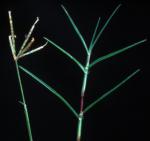Latin name
Cynodon dactylon (L.) Pers.
Family
Poaceae
Common name(s)
Bermuda grass, carpet grass, couch grass
Synonym(s)
Paspalum umbellatum Lam., Cynodon umbellatus (Lam.) Caro, C. erectus J. Presl, C. maritimus Kunth, Capriola dactylon (L.) Kuntze, Panicum dactylon L.
Geographical distribution
Asia: China (Taiwan) and Japan.
South and Southeast Asia: Bangladesh, Bhutan, Cambodia, India, Indonesia, Lao PDR, Myanmar, Nepal, Pakistan, Philippines, Sri Lanka, Thailand, and Vietnam.
Rest of the World: Africa, Argentina, Australia, Dominican Republic, Egypt, El Salvador, Fiji, France, Germany, Greece, Guatemala, Iran, Iraq, Israel, Italy, Jamaica, Lebanon, Mauritius, Mexico, Morocco, Netherlands, Nicaragua, Peru, Portugal, Puerto Rico, Saudi Arabia, Spain, Sudan, Suriname, Turkey, United States (including Hawaii), Venezuela, Yugoslavia, Zambia, and Zimbabwe.
Morphology
A wiry perennial grass with rhizomes and stolons up to 40—cm—tall; variable.
Stem: usually prostrate but sometimes occasionally upright; flowering culms 10—40—cm—high; rhizomes produced below the ground; stolons with roots and tufted shoots arising from the nodes.
Leaf: small and linear, 2—12—cm—long, blue-green, smooth on the lower surface and hairy on the upper with rough margins; ligule a ring of short and fine hairs.
Inflorescence: terminal, 4—5 slender digitate spikes in a single whorl; spikelets slender, purplish, sessile, flattened, 2—mm—long, closely overlapping in two rows along one side of the spike.
Biology and ecology
Well adapted to a wide range of soils including heavy well-drained or sandy soil, and it prefers sunny to lightly shaded dry or moist sites in crops, pastures, rice bunds, lawns, fallows, roadsides, grasslands, forest margins, waste places, and vegetation sites. It can endure long periods of flooding or drought.
Propagates by runners, rhizomes, and seeds. Rhizome fragments with a single bud can develop a shoot from which lateral buds arise to form tillers. Exhibits a seasonal pattern in the storage and depletion of carbohydrate reserves in roots and rhizomes.
Agricultural importance
An alternate host of diseases caused by Cochliobolus miyabeanus, Helminthosporium oryzae, Rhizoctonia solani, and Phyllachora sp., nematodes such as Criconemella onoensis, Hoplolaimus indicus, Pratylenchus indicus, Tylenchorhynchus claytoni, Meloidogyne incognita, and M. javanica, and the viruses that produce stripe disease of rice, barley yellow dwarf, and lucerne dwarf.
Used for lawns, soil stabilization, and feed for livestock. It is an excellent fodder or coarse feed because of its high dry matter content and high crude protein content.
Management
Cultural control: shallow tillage can destroy the seedlings, but repeated deep cultivation in the dry season required to control rhizomes. Controlled by prolonged flooding.
Chemical control: Glyphosate can be an effective control for C. dactylon.
Selected references
Galinato MI, Moody K, Piggin CM. 1999. Upland rice weeds of south and southeast Asia. Manila (Philippines): International Rice Research Institute. 156 p.Holm LG, Plucknett DL, Pancho JV, Herberger JP. 1997. The world's worst weeds. Honolulu, Hawaii (USA): The University Press of Hawaii. 609 p.
Merrill ED. 1976. A flora of Manila. Manila (Philippines): Department of the Interior, Bureau of Science. 491 p.
Moody K. 1989. Weeds reported in rice in south and southeast Asia. Manila (Philippines): International Rice Research Institute. 442 p.
Moody K, Munroe CE, Lubigan RT, Paller Jr. EC. 1984. Major weeds of the Philippines. Weed Science Society of the Philippines. College, Laguna (Philippines): University of the Philippines at Los Baños. 328 p.
Pancho JV. Obien SR. 1995. Manual of ricefield weeds in the Philippines. Muñoz, Nueva Ecija (Philippines): Philippine Rice Research Institute. 543 p.
Soerjani M, Kostermans AJGH, Tjitrosoepomo G. 1987. Weeds of rice in Indonesia. Jakarta (Indonesia): Balai Pustaka,. 716 p.
Contributors
JLA Catindig, RT Lubigan, and DE Johnson
